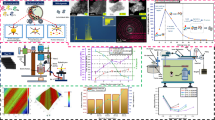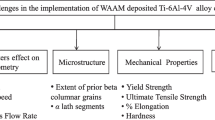Abstract
The present work investigates the Rotary Friction Welding (RFW) of similar AA2024 and dissimilar AA2024/TA6V RFW joints. The effect of friction time on the evolution of microstructure and mechanical properties was investigated to determine the optimal friction time. It was found that the increase of friction time from 2 s to 10 s resulted in improved gradually the mechanical properties of both AA2024/AA2024 and AA2024/TA6V RFW joints and shifted the fracture location from the central zone towards the AA2024 material for the AA2024/TA6V RFW dissimilar joint. The highest tensile strength values recorded were 272.54 MPa and 254.47 MPa for the similar AA2024/AA2024 and the dissimilar AA2024/TA6V RFW joints respectively, both were achieved at 10 s friction time. Scanning electron microscopic (SEM) examination and Energy Dispersive X-ray (EDX) analysis indicated the formation of an interdiffusion band at the interface of the dissimilar AA2024/TA6V RFW joint, consisting of Cu, Al, Ti, Mg, and V atoms. Increasing the friction time enhanced the material mixing and led to the alteration of the fracture mode.

















Similar content being viewed by others
References
American Welding Society (2009) Recommended practices for friction welding. An American National Standard ANSI/AWS C6.1-89, Miami
Hynes NRJ, Velu PS, Nithin AM (2018) Friction push plug welding in airframe structures using Ti-6Al-4V plug. J Braz Soc Mech Sci Eng 40:1–7. https://doi.org/10.1007/s40430-018-1088-6
Lakache HE, May A, Badji R et al (2024) Mechanical behavior and microstructure of dissimilar aluminium/titanium rotary friction weld joints. Metall Res Tech 121:112. https://doi.org/10.1051/metal/2024001
Lakache HE, May A, Badji R et al (2024) Effect of copper interlayer in dissimilar TA6V/AU4G rotary friction weld joints. Weld World 1–11. https://doi.org/10.1007/s40194-024-01771-z
Meisnar M, Baker S, Bennett JM et al (2017) Microstructural characterization of rotary friction welded AA6082 and Ti-6Al-4V dissimilar joints. Mater Des 132:188–97. https://doi.org/10.1016/j.matdes.2017.07.004
Kar A, Kailas SV, Suwas S (2018) Effect of zinc interlayer in microstructure evolution and mechanical properties in dissimilar friction stir welding of aluminum to titanium. J Mater Eng Perform 27:6016–6026. https://doi.org/10.1007/s11665-018-3697-8
Kar A, Choudhury SK, Suwas S et al (2018) Effect of niobium interlayer in dissimilar friction stir welding of aluminum to titanium. Mater Character 145:402–412. https://doi.org/10.1016/j.matchar.2018.09.007
Mukhawana DM, Mashinini PM, Madyira DM (2018) Analysis of the Microstructure and Microhardness of Rotary Friction Welded Titanium (Ti-6AL-V4) Rods. Eleventh South Afric Conf Comput App Mech
Nu HTM, Loc NH, Minh LP (2021) Influence of the rotary friction welding parameters on the microhardness and joint strength of Ti6Al4V alloys. Proc IME B J Eng Manuf 235:795–805. https://doi.org/10.1177/0954405420972549
Cheniti B, Miroud D, Badji R et al (2019) Microstructure and mechanical behavior of dissimilar AISI 304L/WC-Co cermet rotary friction welds. Mater Sci Eng A 758:36–46. https://doi.org/10.1016/j.msea.2019.04.081
Winiczenko R, Goroch O, Krzyńska A et al (2017) Friction welding of tungsten heavy alloy with aluminium alloy. J Mater Process Technol 246:42–55. https://doi.org/10.1016/j.jmatprotec.2017.03.009
Choi JW, Li W, Ushioda K et al (2022) Effect of applied pressure on microstructure and mechanical properties of linear friction welded AA1050-H24 and AA5052-H34 joints. Sci Technol Weld Join 27:92–102. https://doi.org/10.1080/13621718.2020.1719304
Kimura M, Suzuki K, Kusaka M et al (2017) Effect of friction welding condition on joining phenomena and mechanical properties of friction welded joint between 6063 aluminum alloy and AISI 304 stainless steel. J Manuf Process 26:178–187. https://doi.org/10.1016/j.jmapro.2017.02.008
Alves EP, Piorino Neto F, An CY (2010) Welding of AA1050 aluminum with AISI 304 stainless steel by the rotary friction welding process. J Aerosp Technol Manag 2:301–306. https://doi.org/10.5028/jatm.2010.02037110
Li X, Li J, Liao Z et al (2016) Microstructure evolution and mechanical properties of rotary friction welded TC4/SUS321 joints at various rotation speeds. Mater Des 99:26–36. https://doi.org/10.1016/j.matdes.2016.03.037
Avinash M, Chaitanya GVK, Giri DK et al (2007) Microstructure and mechanical behavior of rotary friction welded titanium alloys. Proc World Acad Sci Eng Technol 26:1307–6884
Lakache HE, May A, Badji R (2023) Optimization of the RFW process parameters by using the Taguchi method for the Ti6Al4V Grade-5 alloy. Acta Metall Slovaca 29:155–160. https://doi.org/10.36547/ams.29.3.1883
Stütz M, Pixner F, Wagner J et al (2018) Rotary friction welding of molybdenum components. Int J Refract Met Hard Mater 73:79–84. https://doi.org/10.1016/j.ijrmhm.2018.02.004
Li X, Li J, Jin F et al (2018) Effect of rotation speed on friction behavior of rotary friction welding of AA6061-T6 aluminum alloy. Weld World 62:923–930. https://doi.org/10.1007/s40194-018-0601-y
Eddine L, Abdelghani M, Riad B (2023) Rotary friction welding parameters effects upon mechanical properties and microstructure of AA2024 weld joints. Eng Sol Mech 11:291–298. https://doi.org/10.5267/j.esm.2023.2.003
Lakache HE, May A, Badji R et al (2023) The Impact of the Rotary Friction Welding Pressure on the Mechanical and Microstructural Characteristics of Friction Welds Made of the Alloys TiAl6V4 and 2024 Aluminum. Exp Tech 1–12. https://doi.org/10.1007/s40799-023-00671-z
Lakache HE, May A, Badji R (2023) Parametric Investigation of Similar TiAl6V4 and AA2024 Rotary Friction Weld Joints Using Taguchi-L9 Array Method. Iran J Mater Sci Eng 20:1–11. https://doi.org/10.22068/ijmse.3121
ISO E (2016) 6892-1: 2016 Metallic materials-Tensile testing-Part 1: Method of test at room temperature (ISO 6892-1: 2016), European Committee for Standardization
Oliver WC, Pharr GM (1992) An improved technique for determining hardness and elastic modulus using load and displacement sensing indentation experiments. J Mater Res 7:1564–1583. https://doi.org/10.1557/JMR.1992.1564
Rossi S, Volgare L, Perrin-Pellegrino C et al (2020) Dual Electrochemical Treatments to Improve Properties of Ti6Al4V Alloy. Mater 13:1–16. https://doi.org/10.3390/ma13112479
Kherrouba N, Bouabdallah M, Badji R et al (2016) Beta to alpha transformation kinetics and microstructure of Ti-6Al-4V alloy during continuous cooling. Mater Chem Phys 181:462–469. https://doi.org/10.1016/j.matchemphys.2016.06.082
Mondolfo LF (2013) Aluminum alloys: structure and properties. Elsevier, London, England, pp 693–757
Khan IN, Starink MJ, Yan JL (2008) A model for precipitation kinetics and strengthening in Al–Cu–Mg alloys. Mater Sci Eng A 472:66–74. https://doi.org/10.1016/j.msea.2007.03.033
Yumak N, Aslantaş K (2020) A review on heat treatment efficiency in metastable β titanium alloys: the role of treatment process and parameters. J Mater Res Tech 9:15360–15380. https://doi.org/10.1016/j.jmrt.2020.10.088
Ambriz RR, Jaramillo D (2014) Mechanical behavior of precipitation hardened aluminum alloys welds. Light Met Alloy Appl 1:2–5. https://doi.org/10.5772/58418
Li P, Wang S, Xia Y et al (2020) Inhomogeneous microstructure and mechanical properties of rotary friction welded AA2024 joints. J Mater Res Technol 9:5749–5760. https://doi.org/10.1016/j.jmrt.2020.03.100
Rafi HK, Ram GJ, Phanikumar G et al (2010) Microstructure and tensile properties of friction welded aluminum alloy AA7075-T6. Mater Des 1980–2015(31):2375–2380. https://doi.org/10.1016/j.matdes.2009.11.065
Li P, Li J, Li X et al (2015) A study of the mechanisms involved in initial friction process of continuous drive friction welding. J Adhes Sci Technol 29:1246–1257. https://doi.org/10.1080/01694243.2015.1022499
Fukumoto S, Tsubakino H, Okita K et al (1999) Friction welding process of 5052 aluminium alloy to 304 stainless steel. Mater Sci Technol 15:1080–1086. https://doi.org/10.1179/026708399101506805
Zhao S, Wang M, Kou S et al (2020) Realization of ODS-Cu/T91 Tube-to-tube Joining with Rotary Friction Welding. Fus Eng Des 158:1–6. https://doi.org/10.1016/j.fusengdes.2020.111699
Dressler U, Biallas G, Mercado UA (2009) Friction stir welding of titanium alloy TiAl6V4 to aluminium alloy AA2024-T3. Mater Sci Eng A 526:113–117. https://doi.org/10.1016/j.msea.2009.07.006
Peng G, Ma Y, Hu J et al (2018) Nanoindentation hardness distribution and strain field and fracture evolution in dissimilar friction stir-welded AA 6061-AA 5A06 aluminum alloy joints. Adv Mater Sci Eng 1–12. https://doi.org/10.1155/2018/4873571
Kolařík L, Kolaříková M, Vondrouš P (2014) Mechanical properties of interface of heterogeneous diffusion welds of titanium and austenitic steel. Key Eng Mater 586:178–181. https://doi.org/10.4028/www.scientific.net/KEM.586.178
Qin PT, Damodaram R, Maity T et al (2019) Prashanth, Friction welding of electron beam melted Ti-6Al-4V. Mater Sci Eng A 761:1–6. https://doi.org/10.1016/j.msea.2019.138045
US Department of Defense (1974) Military Handbook: Titanium and Titanium Alloys. Department of Defense, Washington, USA
Combres Y, Champin B (1995) Traitements thermiques des alliages de titane. Techniques de l'Ingénieur, MD2 M1335
Combres Y (1999) Popriétés du titane et de ses alliages. Techniques de l'Ingénieur, MB5 M557
Combres Y (1999) Mise en forme des alliages de titane. Techniques de l'Ingénieur, MC1 M3160
Robert Y (2007) Simulation numérique du soudage du TA6V par laser YAG impulsionnel : caractérisation expérimentale et modélisation des aspects thermomécaniques associés à ce procédé. PhD thesis, Ecole nationale supérieure des Mines, Paris
Leitão C, Louro R, Rodrigues DM et al (2012) Analysis of high temperature plastic behaviour and its relation with weldability in friction stir welding for aluminium alloys AA5083-H111 and AA6082-T6. Mater Des 402:402–409. https://doi.org/10.1016/j.matdes.2012.01.031
Aydin H, Tutar M, Durmuş A et al (2012) Effect of welding parameters on tensile properties and fatigue behavior of friction stir welded 2014–T6 aluminum alloy. Trans Indian Inst Metal 65:21–30. https://doi.org/10.1007/s12666-011-0069-6
Mimouni O, Badji R, Kouadri-David A et al (2019) Microstructure and mechanical behavior of friction-stir-welded 2017A–T451 aluminum alloy. Trans Indian Inst Metal 72:1853–1868. https://doi.org/10.1007/s12666-019-01663-7
Humphreys FJ, Hatherly M (2004) Recrystallization and Related Annealing Phenomena. Elsevier, Oxford, England
Heinz B, Skrotzki B (2002) Characterization of a friction-stir-welded aluminum alloy 6013. Metall Mater Trans B 33:489–498. https://doi.org/10.1007/s11663-002-0059-5
Su JQ, Nelson TW, Mishra R et al (2003) Microstructural investigation of friction stir welded 7050–T651 aluminium. Acta Mater 51:713–729. https://doi.org/10.1016/S1359-6454(02)00449-4
Jata K, Semiatin S (2000) Continuous dynamic recrystallization during friction stir welding of high strength aluminum alloys. Scr Mater 43:743–749. https://doi.org/10.1016/S1359-6462(00)00480-2
Geng P, Qin G, Zhou J et al (2019) Numerical and experimental investigation on friction welding of austenite stainless steel and middle carbon steel. J Manuf Process 47:83–97. https://doi.org/10.1016/j.jmapro.2019.09.016
Jin F, Li J, Du Y (2019) Numerical simulation based upon friction coefficient model on thermomechanical coupling in rotary friction welding corresponding with coronabond evolution. J Manuf Process 45:595–602. https://doi.org/10.1016/j.jmapro.2019.08.001
Li P, Wang S, Dong H et al (2021) Effect of inhomogeneous microstructure evolution on the mechanical properties and corrosion behavior of rotary friction welded AA2024 joints. Mater Charact 178:1–14. https://doi.org/10.1016/j.matchar.2021.111306
Hall EO (1951) The deformation and ageing of mild steel: III discussion of results. Proc Phys Soc 64:747–753. https://doi.org/10.1088/0370-1301/64/9/303
Sasmito A, Ilman MN, Iswanto PT et al (2022) Effect of Rotational Speed on Static and Fatigue Properties of Rotary Friction Welded Dissimilar AA7075/AA5083 Aluminium Alloy Joints. Metal 12:1–24. https://doi.org/10.3390/met12010099
Avettand-Fenoel MN, Nagaoka T, Fujii H et al (2018) Characterization of WC/12Co cermet–steel dissimilar friction stir welds. J Manuf Process 31:139–155. https://doi.org/10.1016/j.jmapro.2017.11.012
Luo JG, Acoff VL (2000) Interfacial reactions of titanium and aluminum during diffusion welding. Weld J 79:239–243
Hynes NRJ, Velu PS (2018) Effect of rotational speed on Ti-6Al-4V-AA 6061 friction welded joints. J Manuf Process 32:288–297. https://doi.org/10.1016/j.jmapro.2018.02.014
Wang GL, Li JL, Wang WL et al (2018) Rotary friction welding on dissimilar metals of aluminum and brass by using pre-heating method. Int J Adv Manuf Technol 99:1293–1300. https://doi.org/10.1007/s00170-018-2572-y
Akinlabi ET, Mahamood RM (2020) Solid-state welding: friction and friction stir welding processes. Springer International Publishing, New York, USA, pp 693–757
Vairis A, Papazafeiropoulos G, Tsainis AM (2016) A comparison between friction stir welding, linear friction welding and rotary friction welding. Adv Manuf 4:296–304. https://doi.org/10.1007/s40436-016-0163-4
Kar A, Kailas SV, Suwas S (2019) Effect of mechanical mixing in dissimilar friction stir welding of aluminum to titanium with zinc interlayer. Trans Indian Inst Metal 72:1533–1536. https://doi.org/10.1007/s12666-019-01643-x
Funding
The authors declare that no funds, grants, or other support were received during the preparation of this manuscript.
Author information
Authors and Affiliations
Corresponding author
Ethics declarations
Conflict of interest
The authors declare no competing interests.
Additional information
Publisher's Note
Springer Nature remains neutral with regard to jurisdictional claims in published maps and institutional affiliations.
Rights and permissions
Springer Nature or its licensor (e.g. a society or other partner) holds exclusive rights to this article under a publishing agreement with the author(s) or other rightsholder(s); author self-archiving of the accepted manuscript version of this article is solely governed by the terms of such publishing agreement and applicable law.
About this article
Cite this article
Lakache, H.E., Badji, R., May, A. et al. Effect of friction time on the metallurgical behavior and mechanical properties of similar AA2024 and dissimilar AA2024/TA6V rotary friction welds. Int J Adv Manuf Technol 133, 835–849 (2024). https://doi.org/10.1007/s00170-024-13755-w
Received:
Accepted:
Published:
Issue Date:
DOI: https://doi.org/10.1007/s00170-024-13755-w




